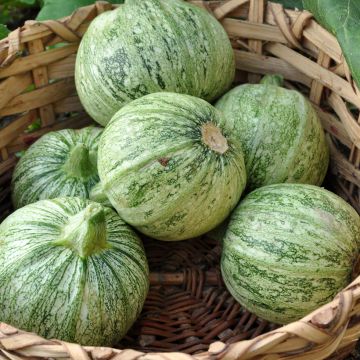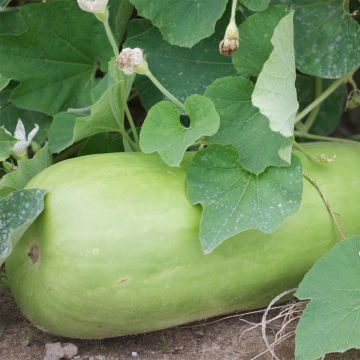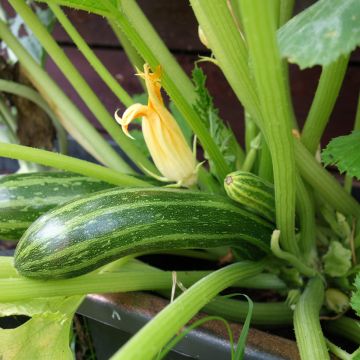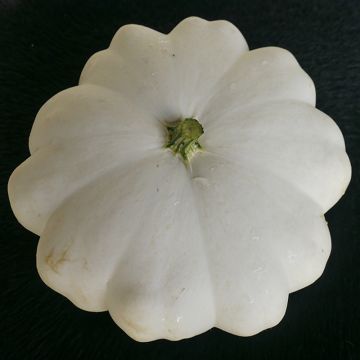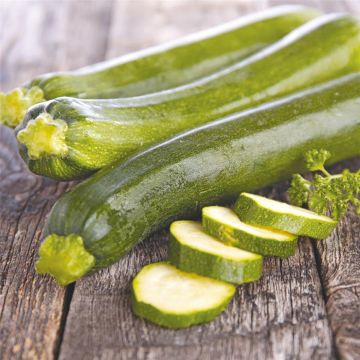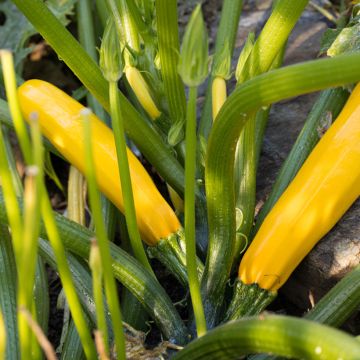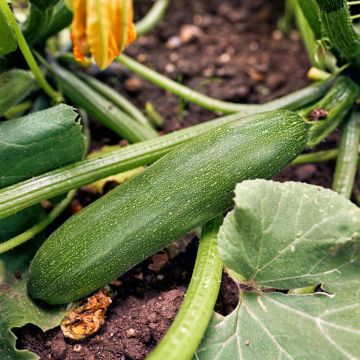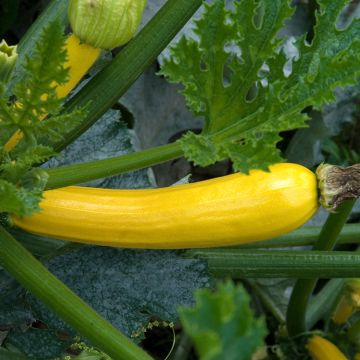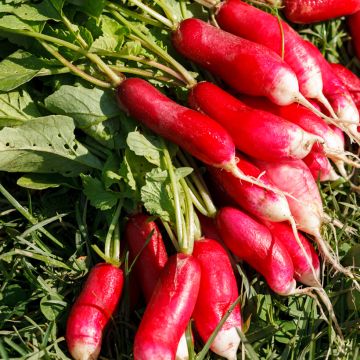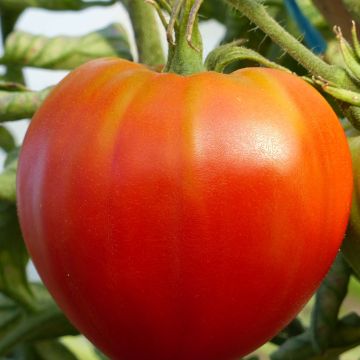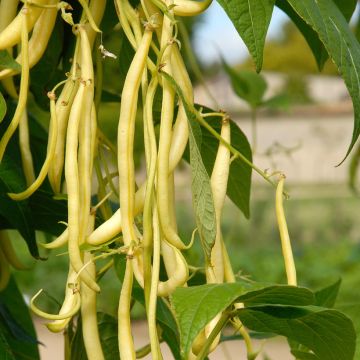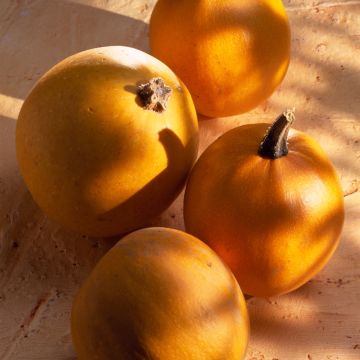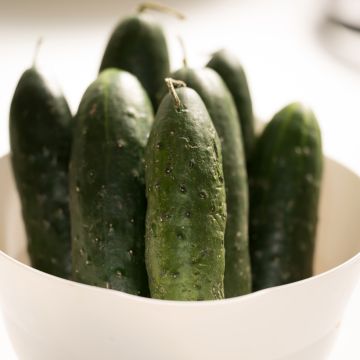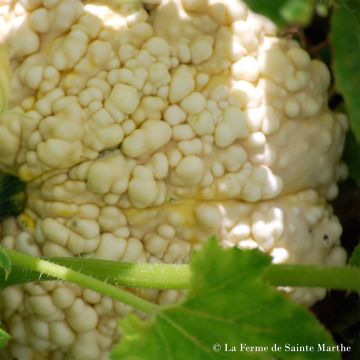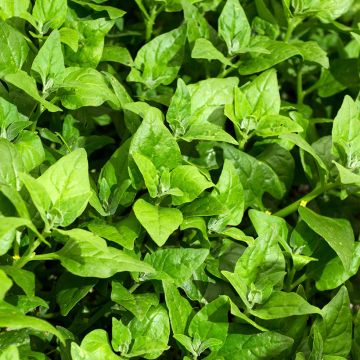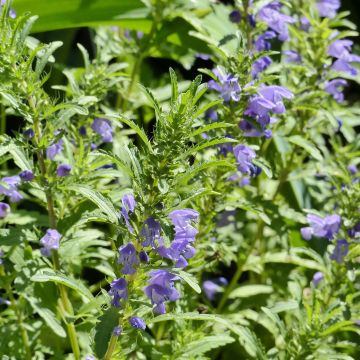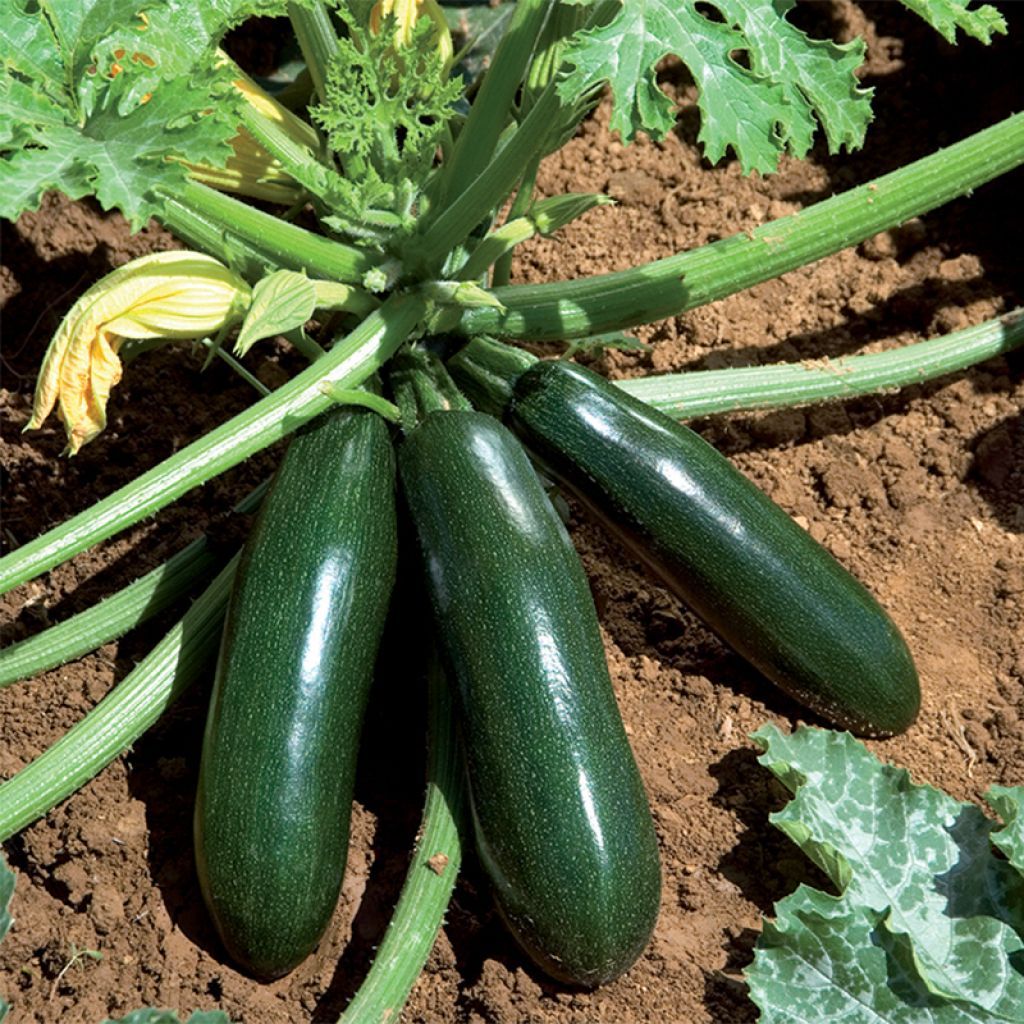

Zucchini Astia F1 Seeds - Cucurbita pepo
Zucchini Astia F1 Seeds - Cucurbita pepo
Cucurbita pepo Astia F1
Zucchini, Summer Squash
This item cannot be shipped to the selected country
Dispatch by letter from €3.90
More information
Schedule delivery date,
and select date in basket
This plant carries a 6 months recovery warranty
More information
We guarantee the quality of our plants for a full growing cycle, and will replace at our expense any plant that fails to recover under normal climatic and planting conditions.
Seed-only orders are dispatched by sealed envelope. The delivery charge for seed-only orders is €3.90.
Description
Cucurbita pepo 'Astia' F1 is a variety of courgette that produces dark green fruits with thin skin and excellent flavour. This early and productive variety is resistant to diseases, especially powdery mildew which often harms this type of plant. Non-trailing and with a compact habit, it takes up little space and is suitable for small gardens. The long and regular fruits are perfect cooked (stir-fried, gratin, soup, stuffed, ratatouille) and raw, grated and mixed with other raw vegetables. Courgettes are easy to grow and will provide a bountiful harvest. For the first sowing, harvesting starts from mid-June and continues until the end of September. It can be grown under cover or in open ground. It appreciates warmth and should be exposed to full sun.
Orange, green, red, yellow, black, or even blue, smooth, ribbed, warty, with tender skin, etc. squashes and courgettes boast an astonishing variability of shapes, colours, sizes. They hybridise with remarkable ease, hence the huge number of varieties.
In common language, winter squash refers to all kinds of pumpkins, potimarrons, pumpkins, etc. with tough skin and delicately sweet flesh. By summer squash or courgettes, we mean the different varieties that are harvested when the skin is still tender and young. These are consumed with the seeds.
They all originate from America and belong to the large Cucurbitaceae family. They were introduced to Europe in the 16th century. There are about ten species of squash, four of which are the most cultivated in our vegetable gardens. These are Cucurbita pepo, Cucurbita moschata or winter squash, Cucurbita maxima and finally Cucurbita argyrosperma:
Cucurbita pepo: these are the most common in vegetable gardens, including certain pumpkins, courgettes, and pattypan squash, among others. including some pumpkins, courgettes, and pattypan squashes, etc. They are generally recognised by their rigid and serrated leaves and their angular peduncle with at least 5 ribs that do not widen at the point of attachment to the fruit.
Cucurbita moschata or winter squash: these plants have soft leaves. The peduncle is very ribbed and visibly widens at the point of attachment to the fruit. The leaves take the shape of a heart.
Cucurbita maxima: these are mainly pumpkins. Their peduncle is rounded and becomes somewhat spongy. As the name of the species suggests, it mainly concerns varieties with large fruits. The leaves have 5 lobes.
Cucurbita argyrosperma: they are very rarely found in our gardens. They have trilobed leaves and a very thick, robust, and non-ribbed peduncle.
Generally trailing, they cling to any support with their tendrils. Female flowers are distinguished from male flowers by their inferior ovary (under the flower), resembling an embryo of fruit. In many regions, male flowers are harvested after pollination to be eaten stuffed or in fritters.
In the kitchen: there are many ways to consume courgettes: sautéed, fried, in gratin, in soups, or stuffed. Courgettes are famous in Provençal ratatouille, Italian caponata, Maghrebian couscous or many emblematic Mediterranean dishes. Courgettes are low in calories, but rich in vitamins, especially provitamin A, vitamin B and minerals.
Harvesting: courgettes are fruits that need a lot of water to give their best. Courgettes are harvested young and fresh. They should be handled with care and remain free of any cuts or bruises.
Storage: courgettes can be stored for a few days at room temperature or in the bottom of a refrigerator. They can be cut into pieces and frozen.
Gardener's tip: courgettes are very susceptible to powdery mildew (a fungal disease that leaves a white fuzz on the leaves). Avoid watering the leaves or flowers. Plant them with Alliums such as chives, onions, or shallots, or with legumes such as beans or peas. To prevent the fruits from coming into direct contact with the ground and rotting from moisture, you can place a slate tile underneath them. Similarly, courgette particularly appreciate slightly moist soils. Mulch around the plants, especially during the height of summer.
Note: this variety is labelled F1 for "F1 hybrid" because it is a variety resulting from the crossbreeding of carefully selected parents to combine their qualities. This results in a variety that can be particularly tasty and/or early, while being resistant to certain diseases. Sometimes criticised or wrongly associated with GMOs, F1 hybrid seeds are appreciated both for their uniformity and their resistance. Unfortunately, their qualities do not pass on to the next generations. It will therefore not be possible to save the seeds for future sowing.
Report an error about the product description
Harvest
Plant habit
Foliage
Botanical data
Cucurbita
pepo
Astia F1
Cucurbitaceae
Zucchini, Summer Squash
Cultivar or hybrid
Annual
Other Courgette seeds
Planting and care
Sowing
The seeds germinate at a temperature between 21 and 35°C (69.8 and 95°F). Germination usually takes between 6 and 10 days, depending on the temperature.
Sow the seeds under cover from April to May. Alternatively, sow directly in the ground from late May to late June.
Harvest from July to October.
In a heated greenhouse (depending on the sowing date and the outside temperature), fill a seed tray or a pot with good seed compost. Sow the seeds to a depth of 2cm (1in). Cover the seeds with compost and keep the substrate moist, but not waterlogged.
When the young plants appear strong enough to be handled, transplant them into pots before transplanting them to the garden, when there is no longer any risk of frost. When planting, respect a spacing of 1m (3ft) in all directions.
For direct sowing, ensure the soil is properly amended and loosened. Sow 3 seeds per 3cm (1in) deep hole, respecting a distance of 1m (3ft) in all directions. When the seedlings are well developed, thin them out, keeping only the strongest plant.
Cultivation
Courgette likes the sun. It is a fairly demanding vegetable that requires fertilised soil. It is wise to add a good amount of mature compost (about 3/4 kg per m²), by raking to a depth of 5cm (2in). Make this application a few months before, after having loosened the soil well.
Courgettes can be prone to powdery mildew: a white film appears on the foliage. Remove the heavily affected leaves and spray with wettable sulphur every two weeks. In case of minor attack, you can also treat the plants with skimmed milk, diluted at 10 to 20% in rainwater. As a preventive measure, avoid watering the foliage. A spray of horsetail decoction can also be applied to strengthen the foliage's resistance.
Seedlings
Care
Intended location
This item has not been reviewed yet - be the first to leave a review about it.
Vegetable seeds
Haven't found what you were looking for?
Hardiness is the lowest winter temperature a plant can endure without suffering serious damage or even dying. However, hardiness is affected by location (a sheltered area, such as a patio), protection (winter cover) and soil type (hardiness is improved by well-drained soil).

Photo Sharing Terms & Conditions
In order to encourage gardeners to interact and share their experiences, Promesse de fleurs offers various media enabling content to be uploaded onto its Site - in particular via the ‘Photo sharing’ module.
The User agrees to refrain from:
- Posting any content that is illegal, prejudicial, insulting, racist, inciteful to hatred, revisionist, contrary to public decency, that infringes on privacy or on the privacy rights of third parties, in particular the publicity rights of persons and goods, intellectual property rights, or the right to privacy.
- Submitting content on behalf of a third party;
- Impersonate the identity of a third party and/or publish any personal information about a third party;
In general, the User undertakes to refrain from any unethical behaviour.
All Content (in particular text, comments, files, images, photos, videos, creative works, etc.), which may be subject to property or intellectual property rights, image or other private rights, shall remain the property of the User, subject to the limited rights granted by the terms of the licence granted by Promesse de fleurs as stated below. Users are at liberty to publish or not to publish such Content on the Site, notably via the ‘Photo Sharing’ facility, and accept that this Content shall be made public and freely accessible, notably on the Internet.
Users further acknowledge, undertake to have ,and guarantee that they hold all necessary rights and permissions to publish such material on the Site, in particular with regard to the legislation in force pertaining to any privacy, property, intellectual property, image, or contractual rights, or rights of any other nature. By publishing such Content on the Site, Users acknowledge accepting full liability as publishers of the Content within the meaning of the law, and grant Promesse de fleurs, free of charge, an inclusive, worldwide licence for the said Content for the entire duration of its publication, including all reproduction, representation, up/downloading, displaying, performing, transmission, and storage rights.
Users also grant permission for their name to be linked to the Content and accept that this link may not always be made available.
By engaging in posting material, Users consent to their Content becoming automatically accessible on the Internet, in particular on other sites and/or blogs and/or web pages of the Promesse de fleurs site, including in particular social pages and the Promesse de fleurs catalogue.
Users may secure the removal of entrusted content free of charge by issuing a simple request via our contact form.
The flowering period indicated on our website applies to countries and regions located in USDA zone 8 (France, the United Kingdom, Ireland, the Netherlands, etc.)
It will vary according to where you live:
- In zones 9 to 10 (Italy, Spain, Greece, etc.), flowering will occur about 2 to 4 weeks earlier.
- In zones 6 to 7 (Germany, Poland, Slovenia, and lower mountainous regions), flowering will be delayed by 2 to 3 weeks.
- In zone 5 (Central Europe, Scandinavia), blooming will be delayed by 3 to 5 weeks.
In temperate climates, pruning of spring-flowering shrubs (forsythia, spireas, etc.) should be done just after flowering.
Pruning of summer-flowering shrubs (Indian Lilac, Perovskia, etc.) can be done in winter or spring.
In cold regions as well as with frost-sensitive plants, avoid pruning too early when severe frosts may still occur.
The planting period indicated on our website applies to countries and regions located in USDA zone 8 (France, United Kingdom, Ireland, Netherlands).
It will vary according to where you live:
- In Mediterranean zones (Marseille, Madrid, Milan, etc.), autumn and winter are the best planting periods.
- In continental zones (Strasbourg, Munich, Vienna, etc.), delay planting by 2 to 3 weeks in spring and bring it forward by 2 to 4 weeks in autumn.
- In mountainous regions (the Alps, Pyrenees, Carpathians, etc.), it is best to plant in late spring (May-June) or late summer (August-September).
The harvesting period indicated on our website applies to countries and regions in USDA zone 8 (France, England, Ireland, the Netherlands).
In colder areas (Scandinavia, Poland, Austria...) fruit and vegetable harvests are likely to be delayed by 3-4 weeks.
In warmer areas (Italy, Spain, Greece, etc.), harvesting will probably take place earlier, depending on weather conditions.
The sowing periods indicated on our website apply to countries and regions within USDA Zone 8 (France, UK, Ireland, Netherlands).
In colder areas (Scandinavia, Poland, Austria...), delay any outdoor sowing by 3-4 weeks, or sow under glass.
In warmer climes (Italy, Spain, Greece, etc.), bring outdoor sowing forward by a few weeks.

































